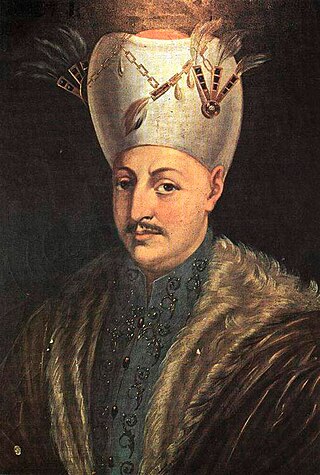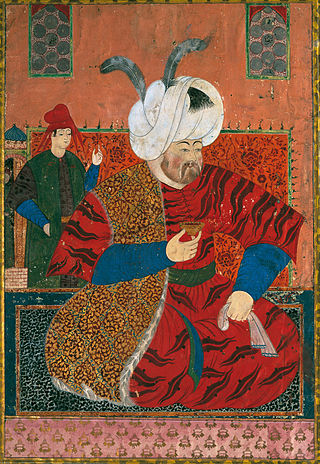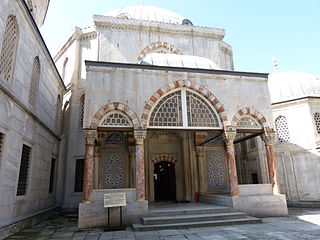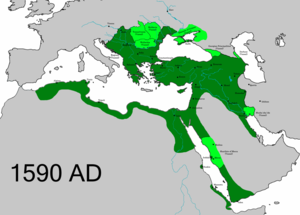
Ahmed I was the sultan of the Ottoman Empire from 1603 to 1617. Ahmed's reign is noteworthy for marking the first breach in the Ottoman tradition of royal fratricide; henceforth, Ottoman rulers would no longer systematically execute their brothers upon accession to the throne. He is also well known for his construction of the Blue Mosque, one of the most famous mosques in Turkey.

Ahmed II was the sultan of the Ottoman Empire from 1691 to 1695.

Bayezid II was the sultan of the Ottoman Empire from 1481 to 1512. During his reign, Bayezid consolidated the Ottoman Empire, thwarted a pro-Safavid rebellion and finally abdicated his throne to his son, Selim I. Bayezid evacuated Sephardi Jews from Spain following the fall of the Nasrid Kingdom of Granada and the proclamation of the Alhambra Decree and resettled them throughout Ottoman lands, especially in Salonica.

Mehmed III was the sultan of the Ottoman Empire from 1595 until his death in 1603. Mehmed was known for ordering the execution of his brothers and leading the army in the Long Turkish War, during which the Ottoman army was victorious at the decisive Battle of Keresztes. This victory was however undermined by some military losses such as in Győr and Nikopol. He also ordered the successful quelling of the Jelali rebellions. The sultan also communicated with the court of Elizabeth I on the grounds of stronger commercial relations and in the hopes of England to ally with the Ottomans against the Spanish.

Murad IV was the sultan of the Ottoman Empire from 1623 to 1640, known both for restoring the authority of the state and for the brutality of his methods. Murad IV was born in Constantinople, the son of Sultan Ahmed I and Kösem Sultan. He was brought to power by a palace conspiracy when he was just 11 years old, and he succeeded his uncle Mustafa I. Until he assumed absolute power on 18 May 1632, the empire was ruled by his mother, Kösem Sultan, as nāʾib-i salṭanat (regent). His reign is most notable for the Ottoman–Safavid War, of which the outcome would partition the Caucasus between the two Imperial powers for around two centuries, while it also roughly laid the foundation for the current Turkey–Iran–Iraq borders.

Selim II, also known as Selim the Blond or Selim the Drunkard, was the sultan of the Ottoman Empire from 1566 until his death in 1574. He was a son of Suleiman the Magnificent and his wife Hurrem Sultan. Selim had been an unlikely candidate for the throne until his brother Mehmed died of smallpox, his half-brother Mustafa was strangled to death by the order of his father and his brother Bayezid was killed on the order of his father after a rebellion against him and Selim.

Ibrahim was the sultan of the Ottoman Empire from 1640 until 1648. He was born in Constantinople, the son of sultan Ahmed I by Kösem Sultan, an ethnic Greek originally named Anastasia.

Nurbanu Sultan was Haseki Sultan of the Ottoman Empire and the legal wife of Sultan Selim II, as well as Valide Sultan as the mother of Sultan Murad III. She was one of the most prominent figures during the time of the Sultanate of Women. Conflicting theories describe her as of Venetian, Jewish or Greek origin. Her birth name may have been Cecilia Venier-Baffo, Rachel or Kalē Kartanou.

Safiye Sultan was the Haseki Sultan of the Ottoman Sultan Murad III and Valide Sultan as the mother of Mehmed III. Safiye was one of the eminent figures during the era known as the Sultanate of Women. She lived in the Ottoman Empire as a courtier during the reigns of at least seven sultans: Suleiman the Magnificent, Selim II, Murad III, Mehmed III, Ahmed I, Mustafa I and Osman II.

Handan Sultan was a consort of Ottoman Sultan Mehmed III, and mother and Valide Sultan to their son Sultan Ahmed I.

Halime Sultan was a consort of Sultan Mehmed III, and the mother of Sultan Mustafa I. The first woman to be Valide Sultan twice and the only to be Valide twice of a same son. She had at least four children with Mehmed: two sons Şehzade Mahmud and Mustafa I, and two daughters, Hatice Sultan and Şah Sultan. She was de facto co-ruler as Valide Sultan from 22 November 1617 to 26 February 1618 and from 19 May 1622 to 10 September 1623, because her son was mentally instable. Halime was also one of the prominent figures during the era known as the Sultanate of Women.

Rabia Sultan was the Haseki Sultan of Sultan Ahmed II of the Ottoman Empire. She was the last woman to have the Haseki title.
Gevherhan Sultan was an Ottoman princess, the daughter of Sultan Selim II and his favorite Nurbanu Sultan. She was the granddaughter of Suleiman the Magnificent and Hürrem Sultan, sister of Sultan Murad III and aunt of Sultan Mehmed III.

Ismihan Sultan was an Ottoman princess, daughter of Sultan Selim II and his favorite concubine, Haseki Sultan and legal wife Nurbanu Sultan. She was the granddaughter of Suleiman the Magnificent and his favourite consort and legal wife Hürrem Sultan, sister of Sultan Murad III and aunt of Sultan Mehmed III.
Ayşe Sultan was an Ottoman princess, daughter of Sultan Murad III and Safiye Sultan, as well as sister of Sultan Mehmed III of the Ottoman Empire.
Hümaşah Sultan, also known as Hüma Sultan, was an Ottoman princess, the daughter of Şehzade Mehmed (1521–1543) and the granddaughter of Sultan Suleiman the Magnificent of the Ottoman Empire, and his favourite consort and legal wife Hurrem Sultan.

Ayşe Raziye Hatun was a lady-in-waiting to Sultan Murad III of the Ottoman Empire.

Fatma Sultan was an Ottoman princess, daughter of Sultan Murad III and Safiye Sultan, and sister of Sultan Mehmed III of the Ottoman Empire.
Mihrimah Sultan was an Ottoman princess, daughter of Sultan Murad III and Safiye Sultan, and sister of Sultan Mehmed III of the Ottoman Empire.
Gazanfer Agha was an Ottoman courtier and politician of Venetian origin. He held the office of Kapıağası for Sultan Murad III part of a network of spies dedicated to manipulating Ottoman politics in favor of Venice.



















